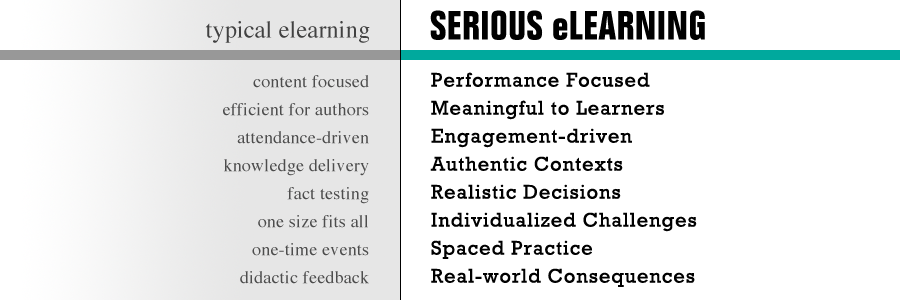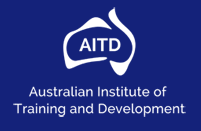We believe that learning technology offers the possibility for creating uniquely valuable learning experiences.
We also believe, with a sense of sadness and profound frustration, that most elearning fails to live up to its promise.
We further believe that current trends evoke a future of only negligible improvement in elearning design—unless something radical is done to bend the curve.
Finally, we have concluded that in order to elevate elearning to the height of its promise, we need to begin with a personal commitment to a new set of standards.
Through continuous assessment of learner performance, the elearning experience can optimize use of the learner’s time, individualize the experience for full engagement, address needs, optimize practice, and prepare for transfer of learning to performance proficiency.
Through our work in developing elearning experiences and helping others do the same, we believe that we need to go beyond typical elearning to the values and characteristics of Serious eLearning:

| Michael Allen | Julie Dirksen |
| Clark Quinn | Will Thalheimer |
Supporting Principles
-
Do Not Assume that Learning is the Solution
We do not assume that a learning intervention is always the best means to helping people perform better.
-
Do Not Assume that eLearning is the Answer
When learning is required, we do not assume that elearning is the only (or the best) solution.
-
Tie Learning to Performance Goals
We will couple the skills we are developing to the goals of organizations, individuals, or both.
-
Target Improved Performance
We will help our learners achieve performance excellence; enabling them to have improved abilities, skills, confidence, and readiness to perform.
-
Provide Realistic Practice
We will provide learners sufficient levels of realistic practice; for example, simulations, scenario-based decision making, case-based evaluations, and authentic exercises.
-
Enlist Authentic Contexts
We will provide learners with sufficient experience in making decisions in authentic contexts.
-
Provide Guidance and Feedback
We will provide learners with guidance and feedback to correct their misconceptions, reinforce their comprehension, and build effective performance skills.
-
Provide Realistic Consequences
When providing performance feedback during learning, we will provide learners with a sense of the real-world consequences.
-
Adapt to Learner Needs
We can and should utilize elearning’s capability to create learning environments that are flexible or adaptive to learner needs.
-
Motivate Meaningful Involvement
We will provide learners with learning experiences that are relevant to their current goals and/or that motivate them to engage deeply in the process of learning.
-
Aim for Long-term Impact
We will create learning experiences that have long-term impact–well beyond the end of instructional events–to times when the learning is needed for performance.
-
Use Interactivity to Prompt Deep Engagement
We will use elearning’s unique interactive capabilities to support reflection, application, rehearsal, elaboration, contextualization, debate, evaluation, synthesization, et cetera—not just in navigation, page turning, rollovers, and information search.
-
Provide Support for Post-Training Follow-Through
We will support instruction with the appropriate mix of after-training follow-through, providing learning events that: reinforce key learning points, marshal supervisory and management support for learning application, and create mechanisms that enable further on-the-job learning.
-
Diagnose Root Causes
When given training requests, we will determine whether training is likely to produce benefits and whether other factors should be targeted for improvement. We will also endeavor to be proactive in assessing organizational performance factors–not waiting for requests from organizational stakeholders.
-
Use Performance Support
We will consider providing job aids, checklists, wizards, sidekicks, planners, and other performance support tools in addition to–and as a potential replacement for–standard elearning interactions.
-
Measure Effectiveness
Good learning cannot be assured without measurement, which includes the following:
- a. Measure Outcomes
Ideally, we will measure whether the learning has led to benefits for the individual and/or the
organization. - b. Measure Actual Performance Results
Ideally, an appropriate time after the learning (for example, two to six weeks later), we will measure whether the learner has applied the learning, the level of success, the success factors and obstacles encountered, and the level of supervisor support where warranted. - c. Measure Learning Comprehension and Decision Making During Learning
At a minimum, during the learning, we will measure both learner comprehension and decision-making ability. Ideally, we would also measure these at least a week after the learning. - d. Measure Meaningful Learner Perceptions
When we measure learners’ perceptions, we will measure their perceptions of the following: their ability to apply what they’ve learned, their level of motivation, and the support they will receive in implementing the learning.
- a. Measure Outcomes
-
Iterate in Design, Development, and Deployment
We won’t assume that our first pass is right, but we will evaluate and refine until we have achieved our design goals.
-
Support Performance Preparation
We will prepare learners during the elearning event to be motivated to apply what they’ve learned, inoculated against obstacles, and prepared to deal with specific situations.
-
Support Learner Understanding with Conceptual Models
We believe that performance should be based upon conceptual models to guide decisions, and that such models should be presented, linked to steps in examples, practiced with, and used in feedback.
-
Use Rich Examples and Counterexamples
We will present examples and counterexamples, together with the underlying thinking.
-
Enable Learners to Learn from Mistakes
Failure is an option. We will, where appropriate, let learners make mistakes so they can learn from them. In addition, where appropriate, we will model mistake-making and mistake-fixing.
-
Respect Learners
We will acknowledge and leverage the knowledge and skills learners bring to the learning environment through their past experience and individual contexts.
We acknowledge that this is an important but not exhaustive list, and further, that the ideas embedded in this list were drawn from, and inspired by, the work and research of many.






